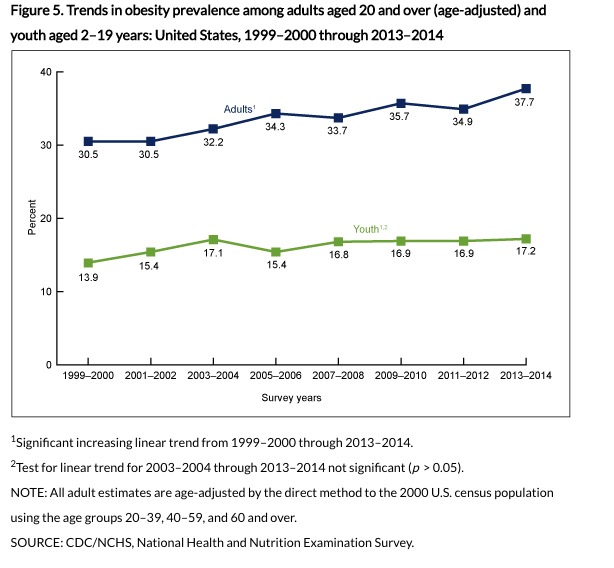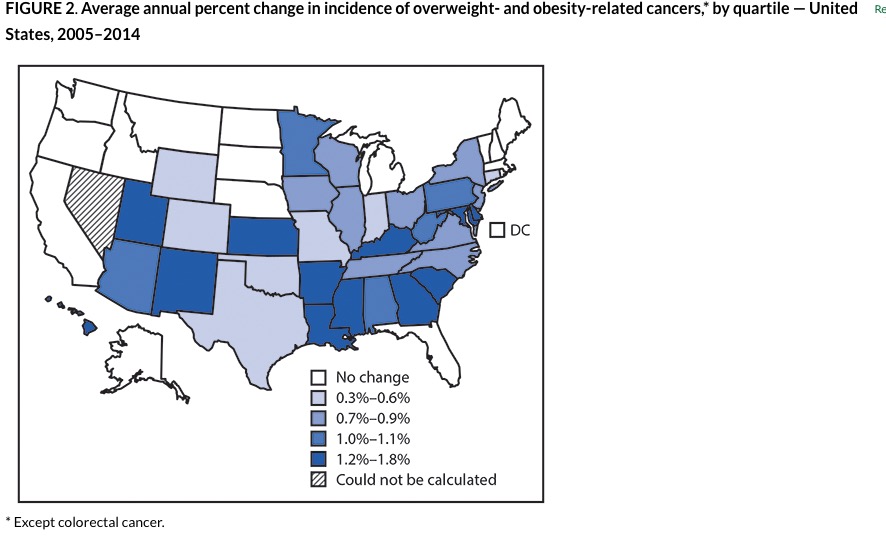By Ruth Kava — December 28, 2017 @ American Council on Science and Health
It's common knowledge that as a country, we've been getting fatter for decades. In some states the prevalence of obesity is over 35 percent, as it is in adults over all, as shown in the graphic below.

Probably it's less widely known that there are at least 13 different types of cancer that are associated with overweight (BMI = 25-29.9) and obesity (BMI = or > 30), according to Dr. C. Brooke Steele of the CDC, and colleagues. These include: adenocarcinoma of the esophagus; cancers of the breast [in postmenopausal women], colon and rectum, endometrium, gallbladder, gastric cardia, kidney, liver, ovary, pancreas, and thyroid; meningioma; and multiple myeloma.
These investigators used data from the US Cancer Statistics database for 2014 to determine new cases of such cancers, as well as assessing trends between 2005 and 2014. They reported that approximately 40 percent of cancers diagnosed in 2014 were among those associated with overweight and obesity and affected about 631,000 persons.
Overweight and obesity-related cancer incidences were greater in people over the age of 50, as one would expect, and were also greater in women than men: 218 VS 115 per 100,000 persons, respectively, because about 42 percent of these cancers affected breast, endometrium, or ovaries. However, for most of those cancers that affected both genders, there were higher incidences in men than in women.
There were also differences in the incidence of these cancers for different ethnic/racial groups, with African Americans having the highest rate, followed by Caucasians. Further, different cancers' rates changed to various extents. For example, between 2005 and 2014 the rate of occurrence of thyroid cancer increased (in both sexes) by 40 percent; that of liver cancer by about 29 percent; but that of stomach cancer (gastric cardia) by only about 1.2 percent.
Using data from cancer registries from 2005 to 2014, the investigators found distinct geographical differences in the trends of overweight and obesity-related cancers as shown in the map below.

These data indicate that during the period when many of the risks of overweight and obesity became widely known, both the occurrence of excess body fat as well as associated kinds of cancers were increasing. Clearly, more must be done to target populations at the greatest risk of overweight and obesity; if there is truly a causal link between overweight, obesity and these cancers, then reducing the prevalence of excess avoirdupois could also reduce the incidence of such cancers.

Probably it's less widely known that there are at least 13 different types of cancer that are associated with overweight (BMI = 25-29.9) and obesity (BMI = or > 30), according to Dr. C. Brooke Steele of the CDC, and colleagues. These include: adenocarcinoma of the esophagus; cancers of the breast [in postmenopausal women], colon and rectum, endometrium, gallbladder, gastric cardia, kidney, liver, ovary, pancreas, and thyroid; meningioma; and multiple myeloma.
These investigators used data from the US Cancer Statistics database for 2014 to determine new cases of such cancers, as well as assessing trends between 2005 and 2014. They reported that approximately 40 percent of cancers diagnosed in 2014 were among those associated with overweight and obesity and affected about 631,000 persons.
Overweight and obesity-related cancer incidences were greater in people over the age of 50, as one would expect, and were also greater in women than men: 218 VS 115 per 100,000 persons, respectively, because about 42 percent of these cancers affected breast, endometrium, or ovaries. However, for most of those cancers that affected both genders, there were higher incidences in men than in women.
There were also differences in the incidence of these cancers for different ethnic/racial groups, with African Americans having the highest rate, followed by Caucasians. Further, different cancers' rates changed to various extents. For example, between 2005 and 2014 the rate of occurrence of thyroid cancer increased (in both sexes) by 40 percent; that of liver cancer by about 29 percent; but that of stomach cancer (gastric cardia) by only about 1.2 percent.
Using data from cancer registries from 2005 to 2014, the investigators found distinct geographical differences in the trends of overweight and obesity-related cancers as shown in the map below.

These data indicate that during the period when many of the risks of overweight and obesity became widely known, both the occurrence of excess body fat as well as associated kinds of cancers were increasing. Clearly, more must be done to target populations at the greatest risk of overweight and obesity; if there is truly a causal link between overweight, obesity and these cancers, then reducing the prevalence of excess avoirdupois could also reduce the incidence of such cancers.
No comments:
Post a Comment